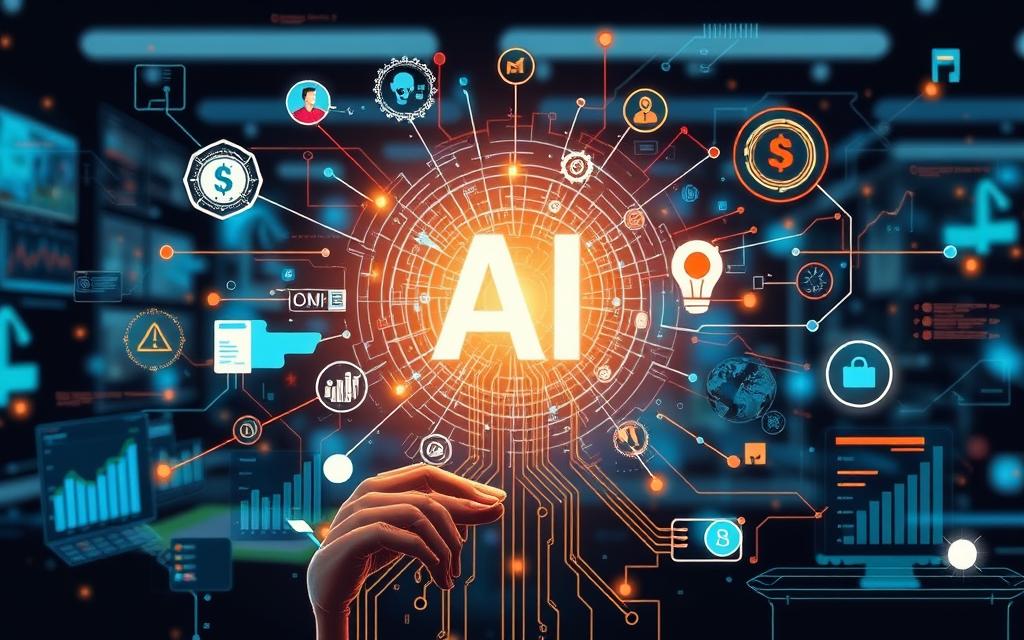Table of Contents
Artificial intelligence is revolutionizing the way we live and work by automating repetitive learning processes and discovering new insights through vast amounts of data.
Instead of just automating manual tasks, AI performs frequent, high-volume, computerized tasks with reliability and speed, without fatigue. By integrating intelligence into existing products, AI enhances their capabilities, making them more efficient and effective.
This beginner’s guide aims to demystify AI, providing a clear understanding of its fundamentals, applications, and impact. We will explore how AI is transforming industries and why understanding it is crucial for individuals and businesses alike, leveraging machine learning models and data to drive innovation.
Demystifying AI: What It Really Means
Understanding AI begins with grasping its fundamental concepts and historical context. As a rapidly evolving field, AI has transitioned from simple rule-based systems to complex neural networks capable of analyzing deeper data.
Defining Artificial Intelligence for Beginners
Artificial Intelligence refers to the development of computer systems that can perform tasks that typically require human intelligence, such as visual perception, speech recognition, and decision-making. For beginners, it’s essential to understand that AI is not just about machine learning; it’s about creating systems that can think and act like humans.
As Andrew Ng once said, “AI is the new electricity. Just as electricity transformed industries, AI will too.” This quote highlights the transformative power of AI in various sectors.
The Historical Evolution of AI
The term “Artificial Intelligence” was coined in the 1950s at the Dartmouth Conference, marking the beginning of AI as a field of study. Since then, AI has gone through several phases of development, including early rule-based systems, expert systems, and the AI winters.
- The advent of more powerful computing and the availability of large datasets enabled the resurgence of AI.
- Breakthroughs in algorithms and learning techniques have been crucial in advancing AI.
- The transition from theoretical AI to practical applications has been significant.
The evolution of AI is a story of continuous improvement, with each generation building upon the last to create more sophisticated systems. Today, AI is integral to many commercial applications, marking a significant shift from its academic origins.
How AI Works: The Technology Behind the Magic
At its core, AI relies on machine learning models and vast amounts of data to function. The integration of these elements enables AI systems to process information, learn from it, and make informed decisions.
Machine Learning Fundamentals
Machine learning is a critical component of AI, allowing systems to improve their performance over time. By training models on large datasets, machine learning algorithms can identify patterns and make predictions. This process involves feeding the system data, which it uses to learn and adapt.
- Machine learning algorithms process information to identify patterns.
- These patterns are used to make predictions and improve system performance.
Neural Networks and Deep Learning Explained
The concept of neural networks is inspired by the human brain’s structure. These networks consist of layers of interconnected nodes or “neurons” that process and transmit information. Deep learning, a subset of neural networks, involves complex networks with multiple layers that can learn hierarchical representations of data, significantly enhancing AI’s capabilities in areas like image recognition and natural language processing.
“Deep neural networks achieve incredible accuracy through multiple processing layers.”
This technology has revolutionized AI, enabling applications that were previously unimaginable. As intelligence systems continue to evolve, their potential to transform industries grows.
Core Capabilities of AI
At the heart of AI’s transformative power are its core capabilities, which enable machines to learn, analyze, and make decisions based on vast amounts of data. These capabilities are foundational to understanding how AI can drive innovation and efficiency across various sectors.
Automated Learning and Pattern Recognition
AI’s ability to automate learning and recognize patterns is a game-changer in data analysis. Through sophisticated algorithms, AI systems can identify complex patterns within large datasets, enabling predictive analytics and informed decision-making. This capability is crucial for applications such as image recognition, natural language processing, and predictive maintenance.
Data Processing and Analysis Capabilities
The data processing capabilities of AI are unparalleled, allowing for the analysis of vast amounts of structured and unstructured data to extract valuable insights. AI-driven analysis transforms raw data into actionable intelligence, driving business strategy and decision-making. Key aspects include:
- Processing and analyzing massive datasets at speeds impossible for humans
- Extracting meaningful insights from diverse data types, including text, images, and sensor data
- Identifying correlations and causations within complex datasets
- Enabling real-time data processing for dynamic responses to changing conditions
Types of AI Systems in Today’s World
Understanding the different types of AI systems is crucial for harnessing their potential. AI adapts through progressive learning algorithms, allowing data to drive programming.
Narrow vs. General AI
AI systems can be categorized into Narrow or General AI. Narrow AI is designed to perform a specific task, such as facial recognition or language translation. General AI, on the other hand, aims to mimic human intelligence across a wide range of tasks.
Learning Methods: Supervised, Unsupervised, and Reinforcement
AI learning methods are crucial for their development. There are three primary methods:
- Supervised Learning: Trained with labeled data, where correct answers are provided. It’s used in applications like spam detection and predictive analytics.
- Unsupervised Learning: Finds patterns in unlabeled data without predefined outcomes. It’s useful for customer segmentation and anomaly detection.
- Reinforcement Learning: Trained through reward signals in interactive environments. It’s driving advancements in robotics and autonomous systems.
| Learning Method | Description | Applications |
|---|---|---|
| Supervised | Trained with labeled data | Spam detection, Predictive analytics |
| Unsupervised | Finds patterns in unlabeled data | Customer segmentation, Anomaly detection |
| Reinforcement | Trained through reward signals | Robotics, Autonomous systems |
These machine learning approaches are often combined in sophisticated AI models, enhancing their capabilities. The choice of training method depends on the available data and the problem type.
Practical AI Applications Transforming Industries

The practical applications of AI are transforming industries in unprecedented ways. Many products we use daily are being enhanced with AI capabilities, much like Siri was introduced as a feature in a new generation of Apple products.
Business and Enterprise Use Cases
AI is being utilized in business and enterprise settings to improve efficiency and decision-making. Automation, conversational platforms, and smart machines are combined with large amounts of data to enhance various technologies. Companies are leveraging AI for language processing and search functionalities to streamline operations.
For instance, AI-powered chatbots are being used for customer service, while predictive analytics is helping businesses forecast market trends.
Consumer-Facing AI Applications
AI is also making a significant impact on consumer-facing applications. Virtual assistants like Siri, Alexa, and Google Assistant are prominent examples of consumer AI. Recommendation systems on streaming platforms and e-commerce sites use AI to personalize experiences, enhancing user engagement.
Other examples include AI-powered features in smartphones, such as computational photography and voice recognition, as well as navigation apps that optimize routes and predict traffic.
Enterprise AI: Powering Business Innovation
Enterprise AI is at the forefront of business innovation, enabling companies to make data-driven decisions. To explore how AI can transform your business, learn more about creating real business value through.

Industry-Specific AI Solutions
Different industries are leveraging AI in unique ways. For instance, C3 AI Platform offers a comprehensive suite for developing and operating Enterprise AI applications. H2O.ai provides a flexible solution that can be deployed in various environments, including cloud, hybrid, and on-premise setups. These industry-specific AI solutions are tailored to meet the distinct needs of different sectors.
How Organizations Implement AI at Scale
Implementing AI at scale requires a strategic approach. Organizations focus on developing a robust data infrastructure and governance framework. They also establish centers of excellence to oversee AI initiatives. Furthermore, the use of cloud platforms and containerization enables scalable AI deployment. By integrating AI capabilities through APIs and microservices, businesses can measure ROI and drive business impact.
AI Development Ecosystem

The AI development ecosystem encompasses a broad spectrum of tools, from no-code solutions to professional development environments. This diversity allows developers to choose the best approach for their specific needs, whether it’s rapid prototyping or complex model development.
No-Code and Low-Code AI Development
No-code and low-code AI development platforms have democratized access to AI, enabling users to create models without extensive coding knowledge. These platforms, such as H2O.ai, provide visual interfaces for building and deploying AI models, making AI more accessible to a broader audience.
By simplifying the development process, no-code and low-code platforms accelerate the adoption of AI across various industries.
Professional AI Development Tools and Platforms
For more complex AI projects, professional tools and platforms are essential. C3 AI, for example, utilizes industry-standard code editors like Visual Studio and Jupyter Notebook, alongside programming languages such as Python, R, and Scala. These professional environments support advanced data science tasks, including data preparation, model training, and deployment.
Cloud-based AI development platforms from major providers like AWS, Azure, and Google Cloud further enhance the ecosystem by offering scalable infrastructure and integrated services for AI development.
Benefits and Challenges of Implementing AI
The journey to AI implementation is marked by both promising advantages and complex hurdles. As organizations navigate this landscape, understanding the transformative benefits and potential challenges is essential for successful adoption.
Transformative Advantages of AI Technology
AI technology offers numerous benefits, including enhanced data analysis capabilities and improved decision-making processes. By leveraging AI models, businesses can gain valuable insights from their data, driving innovation and efficiency. For instance, AI-powered risk management solutions, such as those offered by H2O.ai, enable organizations to assess and mitigate risks more effectively.
Overcoming AI Implementation Challenges
Despite the benefits, AI implementation poses several challenges, including data quality issues and the need for significant organizational change. To overcome these hurdles, businesses must invest in robust data management practices and develop strategies for addressing potential risks associated with AI adoption. By doing so, organizations can ensure a smooth transition to AI-driven operations and maximize the benefits of their AI investments.
Responsible AI: Ethics and Best Practices
As AI becomes increasingly integral to our daily lives, the need for responsible AI practices has never been more pressing. This involves not just developing AI systems that are efficient and effective, but also ensuring they are ethical, equitable, and sustainable.
Privacy, Security, and Compliance Considerations
To build trustworthy AI, it’s crucial to address privacy, security, and compliance considerations. This includes implementing automated testing and human-calibrated evaluations to ensure transparency and boost compliance and risk management. Ensuring that AI systems are secure and compliant with regulatory requirements is essential to mitigate risks associated with data breaches and non-compliance.
Building Trustworthy AI Systems
Building trustworthy AI systems requires a multifaceted approach. It involves defining the characteristics of trustworthy AI, such as fairness, transparency, accountability, and robustness. Additionally, it’s essential to detect and mitigate bias in AI models and decisions, ensuring accuracy and promoting trust among users and stakeholders.
According to experts, “Using data to innovate responsibly requires trustworthy AI.” This underscores the importance of ethical AI development and deployment.
Conclusion: Embracing the AI Revolution
As we stand on the cusp of an AI-driven future, it’s clear that artificial intelligence is not just a technological advancement, but a catalyst for innovation. Throughout this guide, we’ve explored the fundamentals of AI, its capabilities, and its transformative potential across industries.
The power of AI lies in its ability to learn and improve through complex models and vast datasets, enabling organizations to gain competitive advantages through enhanced efficiency, accuracy, and insight. As AI technologies continue to evolve, it’s crucial to balance the opportunities presented by AI with the responsibilities that come with its implementation.
For those looking to explore AI further, the journey begins with understanding its applications and potential in your specific context. Visit Forbes for more insights on embracing the AI revolution. By embracing AI thoughtfully, we can harness its potential to drive innovation and shape a brighter future.
FAQ
What is the primary function of machine learning in AI systems?
Machine learning enables AI systems to learn from data, identify patterns, and make predictions or decisions without being explicitly programmed.
How do neural networks contribute to the capabilities of AI?
Neural networks, particularly deep learning models, allow AI systems to process complex data, such as images and speech, and improve their performance on tasks like image recognition and natural language processing.
What is the difference between narrow and general AI?
Narrow AI is designed to perform a specific task, whereas general AI is a hypothetical AI system that possesses the ability to perform any intellectual task that a human can.
How do organizations implement AI at scale?
Organizations implement AI at scale by developing a robust data infrastructure, adopting a cloud-based AI development platform, and fostering a culture of innovation and experimentation.
What are some common challenges associated with AI implementation?
Common challenges include ensuring data quality, addressing bias in AI models, and developing strategies to mitigate job displacement and other societal impacts.
How can businesses ensure the security and compliance of their AI systems?
Businesses can ensure security and compliance by implementing robust data governance policies, conducting regular audits, and staying up-to-date with relevant regulations and industry standards.
What role do no-code and low-code AI development tools play in the AI ecosystem?
No-code and low-code AI development tools enable non-technical users to develop and deploy AI models, accelerating the adoption of AI across industries and democratizing access to AI technology.
How do AI applications transform industries and consumer experiences?
AI applications transform industries by automating processes, improving decision-making, and enabling new products and services, while also enhancing consumer experiences through personalized recommendations and streamlined interactions.









